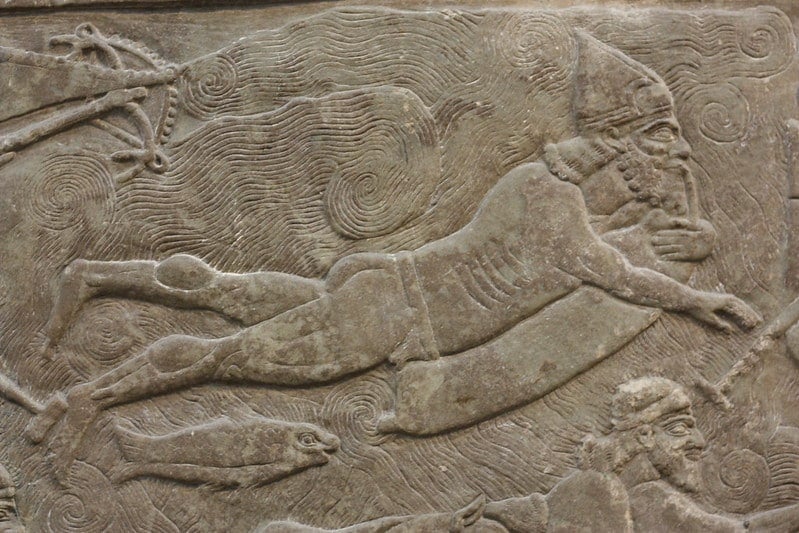

If one wants a fascinating glimpse into warfare from 3,000 years ago, one only need to take a look at the British Museum’s wall panel relief of an ancient Assyrian diver and warrior.
The intriguing relief of the Assyrian diver, roughly an ancient equivalent of the US Navy SEALs Special Forces, is housed for public viewing at the Nimrud collection of the British Museum’s Northwest Palace.
The description of the gypsum wall relief reads, “…the crossing of a river. Horses swim, led by grooms, while a chariot, bed and jar are carried on coracles. Figures are shown complete and not half submerged which is typical of Assyrian art.”
The artifact belongs to the Neo-Assyrian period and is dated to 865-860 BC, during the reign of King Ashurnasirpal II. The detail of an Assyrian warrior floating on water, holding on a floatation apparatus with a mouthpiece is, for modern viewers, possibly the most captivating aspect.
The Assyrian soldiers used the rivers as thoroughfares, carrying with them their military machinery and vehicles without making noise. They used inflated animal skins as floatation devices to move in rivers, hauling dismantled carriages and siege machines.
Ancient Assyrians’ innovative warfare strategies helped them establish one of history’s most powerful empires, relying, to a large extent, on tactical river crossings and stealth operations. This was especially so during the reign of Ashurnasirpal II and, later on, Ashurbanipal.
Aside from the Assyrians, there are also other known divers of antiquity. In 480 BC, for instance, a Greek sculptor named Scyllis was said to have hidden underwater using a reed as a snorkel. He was on a mission to detach Persian enemy ships from their moorings during the Battle of Salamis. In yet another version of the story, he was captured by the Persians and held hostage aboard one of their ships. However, he escaped and swam nine miles to rejoin his countrymen with the help of a hollow reed as a makeshift snorkel.
Moreover, the ancient Greek philosopher Aristotle, the teacher of Alexander the Great, wrote about kettles being utilized to transport air down to divers during the harvest season of marine floor plants. The extra air allowed the divers to stay down longer and hence harvest more than they normally would have had they needed to come up for air more often.
According to later accounts and legends, Aristotle is said to have spoken about a man who descended to an impressive depth of about 82 feet (25 meters) in a clear glass diving bell reinforced with metal bands, while, in Persia, ancient skin-divers developed goggles providing better underwater vision. The goggles were made of thin slivers of polished tortoise shell.
Assyrian King Ashurnasirpal II (r. 883-859 ΒC) is known for his wars of conquest. He would first secure the defense of Assyria and then launch raids against enemies to take over new territories. This was done primarily for economic benefit, as Assyria’s economic prosperity financed the empire’s war machine for additional conquests, and he also utilized a similar strategy in his campaign in the Levant.
An example of the use of sound strategies in defeating enemies is the silent river crossing tactic whereby Assyrian diver warriors provided their people’s armies with crucial methodical advantages. The application of sophisticated plans of action was an incredible achievement for such an ancient civilization and deserves to be highlighted.
Ashurnasirpal’s successor, Shalmaneser III, reigned for thirty-five years, and, although he spent thirty-one years in expanse campaigns, he was never as successful as his predecessor. When Ashurnasirpal passed away, the Assyrian Empire also lost their potency to an extent for some time, although this was later recovered under Tiglath-Pileser III (r. 745-727 BC).
The Neo-Assyrian emperor introduced reforms allowing Assyria to reestablish itself as the most powerful empire in the Near East. Later on, Shalmaneser V, Sargon II, and Sennacherib also contributed with expansive offensives for more conquests, furthering the empire’s might.
Nonetheless, the fact that Assyria was constantly at war also led to the loss of many lives, and the Neo-Assyrian Empire’s manpower was significantly diminished. Eventually, Esarhaddon, who ruled from 681 to 669 BC, succeeded in taking lower Egypt while his successor, Ashurbanipal, conquered the southern upper half of Egypt. By the end of Ashurbanipal’s reign, however, the Assyrian Empire struggled to maintain control, having been significantly weakened yet again.
